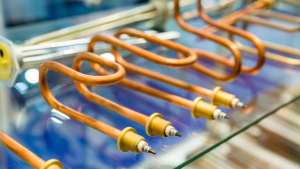Over the last decades heating, ventilation, and air-conditioning systems became significantly more energy efficient. This is immensely important as they are one of the largest energy-consuming loads in commercial and residential buildings. Smooth performance of the systems requires careful installation, thorough cleaning, and regular maintenance.
Running an HVAC system (energy) efficiently is challenging because of constantly changing variables: people entering and leaving a building, changing temperatures and seasons which affect the heating, cooling, and air quality immensely. Research by the European Commission found that buildings are responsible for 40% of all European energy consumption.
Emission reduction goals
This has a significant environmental impact and will become more expensive over the next centuries while countries work on their net-zero and emission reduction goals. How can the HVAC industry, in cooperation with the green tech sector, ensure less energy consumption and fewer CO2 emissions? Are any other energy-saving options available?
Energy-focused digital twins can be used for the planning, operation, and optimization of systems
Following, three data-driven solutions for more energy efficiency in buildings are presented. To understand and operate a technical system it is necessary to have a precise understanding of the system’s parameters and boundaries. HVAC systems are installed in buildings. Buildings, although varying in size, purpose, and layout, can be described by a set of parameters called a digital twin. Energy-focused digital twins can be used for the planning, operation, and optimization of systems.
Machine learning algorithms
In HVAC applications, a digital twin can be used to design and operate equipment more precisely. It helps to detect defects quicker or even before a failure appears. This saves maintenance costs and reduces potential downtimes. The biggest potential of energy-focused digital twins might be the possibility to use those data sets to train machine learning algorithms.
This allows the use of artificial intelligence to optimize HVAC systems. It can raise the energy efficiency of these systems and significantly reduce costs and CO2 emissions. Machine learning offers the HVAC industry immense possibilities. Tracking energy usage on building and room level generates a valuable data set that can be used to operate HVAC systems more energy efficient.
Tracking room utilization
AI can also consider the exact number of people present in the building when regulating the temperature
One example of the use of AI to achieve more energy efficiency is temperature control in buildings. No matter what time of day or night, nor outside temperature or season, the AI algorithm can optimize the temperature in the building according to those variables.
AI can also consider the exact number of people present in the building when regulating the temperature. This is important as the number of people and their body heat change the room temperature significantly. The system reacts to all variables by heating more or cooling down further. While it is possible to count people while entering and leaving a building, it is also possible to track their room utilization. The algorithm can not only notice the changing temperatures in rooms caused by body heat.
Overall energy consumption
It is also able to track where the lights are turned on and off and at what times. Possible reoccurring patterns in those actions can be identified by the algorithm. All this information can be considered when adapting building and room temperature. Tracking people’s actions gives AI detailed information to incorporate into the optimization processes to achieve more energy efficiency. In the same manner, air quality and humidity can be optimized.
Especially in commercial buildings, the ventilation is often running too high
Especially in commercial buildings, the ventilation is often running too high. Over ventilation is a large waste of energy. If fewer people are in the building it should be lowered to reduce the overall energy consumption. Especially in a work environment, both temperature and ventilation are of high importance, as it has a direct impact on the productivity of most people.
Smart Control system
A smart control system will process all available data on the energy usage in a building and adjust the HVAC system accordingly, in real-time. The more information it can gather for a longer period, the better the system becomes. This saves energy, emits less CO2 and reduces costs. A manual adjustment will never be as efficient, as the number of variables is too large.
Additionally, AI can identify any irregularities occurring in the HVAC system and alert the responsible person. Predictive maintenance ensures less downtime. Voltage optimization based on a building’s energy consumption data is a solution that can also enhance energy efficiency in buildings. It can be applied to reduce costs, electrical energy consumption and CO2 emissions. Optimizing the voltage level in real-time means reducing it to a lower level, based on the consumption of the building.
Highest savings level
The CE certification shows that fluctuations of voltage can be tolerated by a device
Electrical energy is supplied to buildings by grid operators. They are supposed to supply 230 V. However, a constant voltage level cannot be guaranteed. The voltage fluctuates. Therefore, all electronic devices must be able to work within those fluctuations.
They allow a range of plus and minus 10%, which is compulsory by law. The CE certification shows that fluctuations of voltage can be tolerated by a device. 10% of 230 V allows the reduction of the voltage level to a minimum level of 207 V. At this level, all devices in buildings are guaranteed to run smoothly. Every volt above 207 V can thus be considered more than necessary for the devices to work properly. This means, that at the highest savings level, all devices still work within their specifications.
Lower electricity costs
Consuming less energy results in a reduced carbon footprint and lower electricity costs
This provides less energy consumption and less CO2 emissions. As buildings and their HVAC systems are consuming large amounts of energy which emits tons of CO2 every year, enhancing the energy efficiency in buildings becomes crucial on the way to net-zero.
Energy-Saving solutions
HVAC systems must work with the highest energy efficiency possible, considering that the weather extremes we are experiencing all over the world (colder winters and hotter summers)will increase the demand for them, if not make them indispensable. But these solutions are not only available for new buildings.
Existing buildings can also be retrofit by their owners and operators to take advantage of the emerging data-driven trends in the green tech industry. Energy-saving solutions like voltage optimization can significantly reduce buildings’ carbon footprints. Combing several different data- driven energy-saving solutions will reduce the carbon emissions in the building sector significantly.













